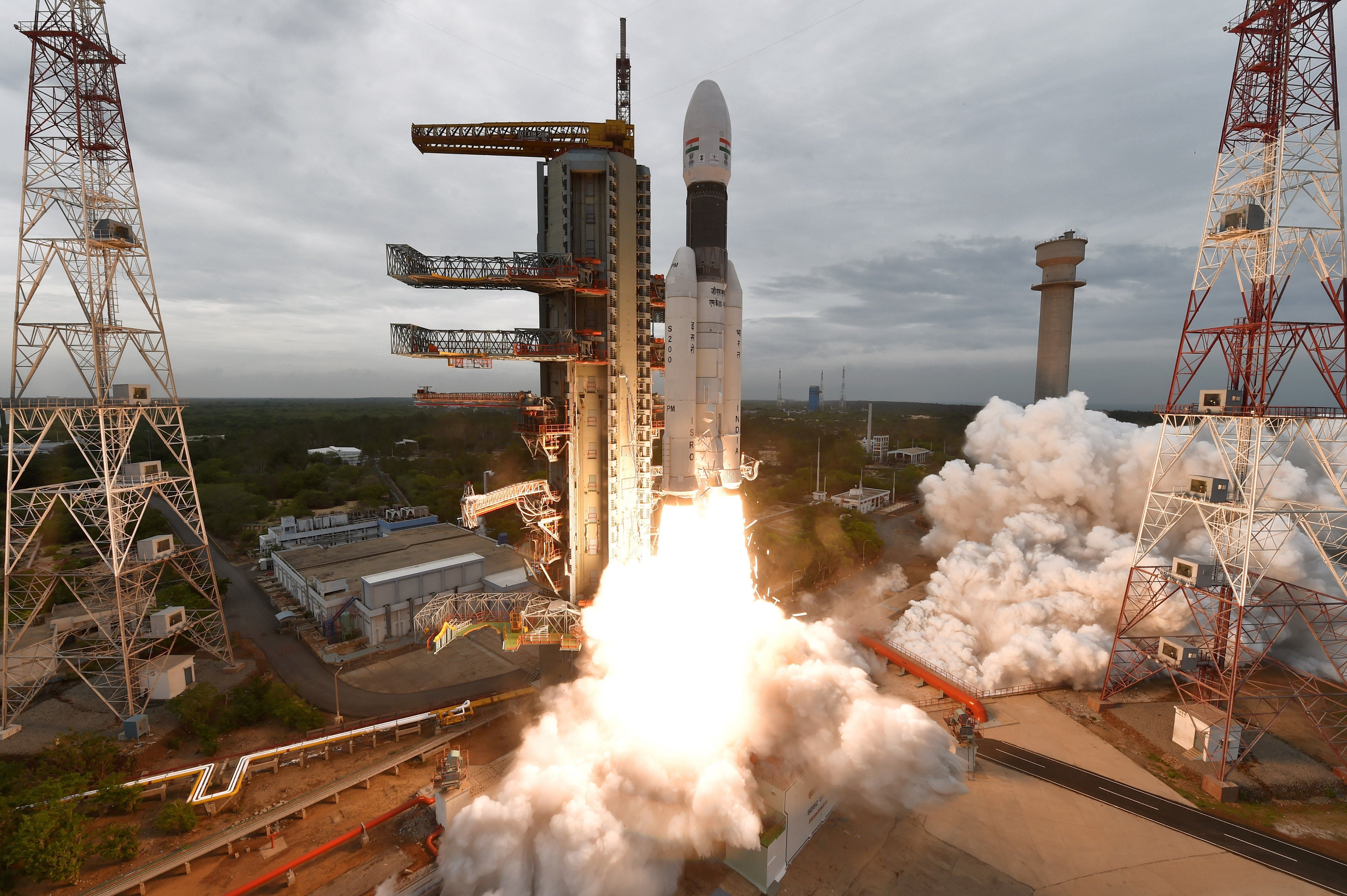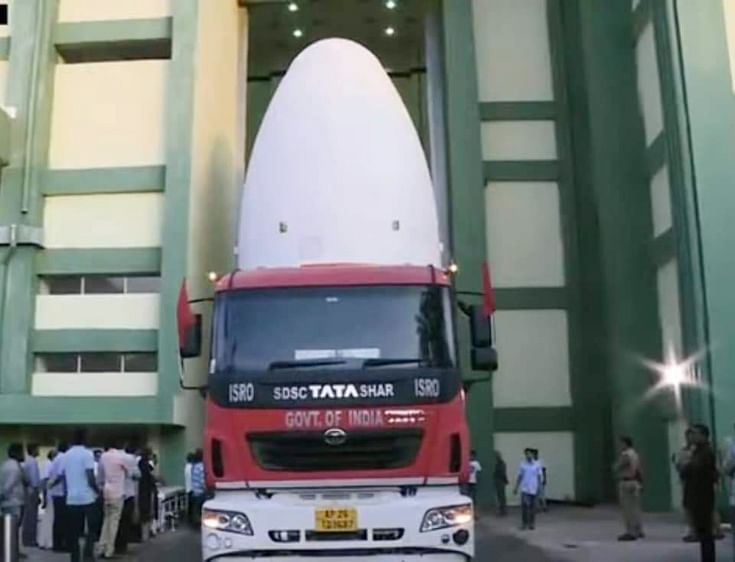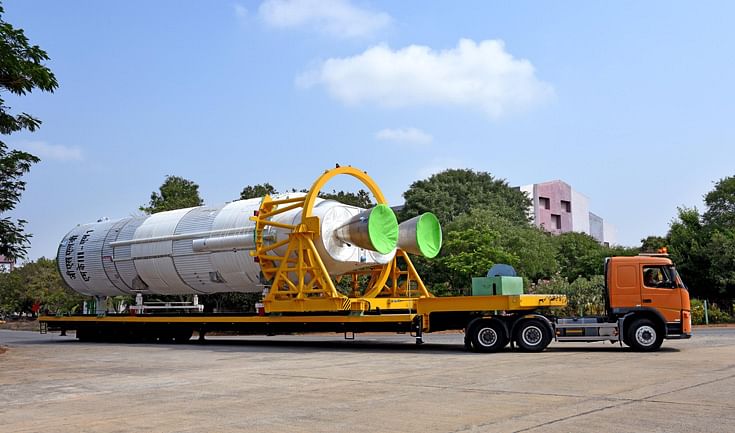Tata Motors and Volvo lend wheels to ISRO's Chandrayaan 2 mission
Two heavy-duty trucks provided some pulling power to the Chandrayaan-2 spacecraft, which was launched today at Sriharikota.
India’s Geosynchronous Satellite Launch Vehicle (GSLV MkIII-M1) successfully launched Chandrayaan-2 spacecraft at 2:43 pm today into its planned orbit with a perigee (the nearest point to Earth) of 169.7km and an apogee (the farthest point to Earth) of 45,475km. The launch took place from the second launch pad at Satish Dhawan Space Centre, Sriharikota.

Majestic lift off of GSLV MkIII-M1 carrying Chandrayaan 2, which will be the first spacecraft to land close to the moon’s South Pole, on September 2.
(Image: ISRO/Twitter ).
Chandrayaan 2 will be the first spacecraft to land close to the moon’s South Pole in around 50 days from today. As Prime Minister Narendra Modi tweeted, “Chandrayaan 2 is unique because it will explore and perform studies on the South Pole region of lunar terrain which is not explored and sampled by any past mission.”
Chandrayaan 2: India's second lunar mission explained
Chandrayaan-2, India’s second lunar mission, has three modules – Orbiter, Lander (Vikram) and Rover (Pragyan). The Orbiter and Lander modules will be interfaced mechanically and stacked together as an integrated module and accommodated inside the GSLV MK-III launch vehicle.
The Rover is housed inside the Lander. After launch into earth-bound orbit by GSLV MK-III, the integrated module will reach Moon orbit using Orbiter propulsion module. Subsequently, Lander will separate from the Orbiter and soft land at the predetermined site close to lunar South Pole. Further, the Rover will roll out for carrying out scientific experiments on the lunar surface. Instruments are also mounted on Lander and Orbiter for carrying out scientific experiments.
On the day of landing, the Lander (Vikram) will separate from the Orbiter and then will perform a series of complex manoeuvres comprising rough braking and fine braking. Imaging of the landing site region prior to landing will be done for finding safe and hazard-free zones. Vikram will attempt to make a soft landing in a high plain between two craters — Manzinus C and Simpelius N — at a latitude of about 70deg South on September 7, 2019.
Subsequently, the Rover (Pragyan) will roll out and carry out experiments on the lunar surface for a period of one lunar day which is equal to 14 earth days. The mission life of Vikram is also one lunar day. The Orbiter will continue its mission for a duration of one year.
Tata Motors and Volvo do their bit
What's interesting is that the GSLV MkIII-M1 vehicle's payload module, which weighs 3,850 kilograms, was transported by a 49-tonne (4928) Tata Prima tractor-trailer. The Prima heavy-duty truck is powered by a Cummins 6.7-litre, common-rail ISBe 270 direct-injection turbocharged 267hp engine that also develops 970 Nm of torque at 1200-1700rpm.

The Prima range ranks as Tata’s most modern trucks, both for haulage and special heavy-duty applications. Launched in 2009 as the ‘World Truck’, the Prima range is equipped with the most modern aggregates with powerful engines for carrying maximum loads.
A Volvo FM 400 HD (heavy duty) truck was used for the transportation of the liquid L110 stage for integration during the assembly stage. The truck used here comes with a 13-litre engine with a max power of 500hp. The Volvo FM 400 HD comes with special crawler gears that further enhance the precision for carrying super max-size loads. The L110 stage has 2 Vikas engines and weighs 110 tonnes without the fuel.

The Volvo FM 400 HD, which transported the liquid L110 stage for integration during the assembly stage, has special crawler gears that further enhance the precision for carrying super max-size loads.
RELATED ARTICLES
JSW MG Motor launches Comet EV Blackstorm edition
The key highlights of the Comet EV Blackstorm, which is now the top-end variant, are its ‘Starry Black’ exterior along w...
Maruti Suzuki begins production at new Kharkhoda plant
Phase 1 of the Kharkhoda plant will have an annual production capacity of 250,000 units and produce the Brezza compact S...
Eurogrip aims for price parity with ICE in low rolling resistance tyres
With its two-pronged approach that focuses on optimising energy consumption in the manufacturing process of low rolling ...





 By Autocar Pro News Desk
By Autocar Pro News Desk
 22 Jul 2019
22 Jul 2019
 29638 Views
29638 Views












 Ajit Dalvi
Ajit Dalvi


